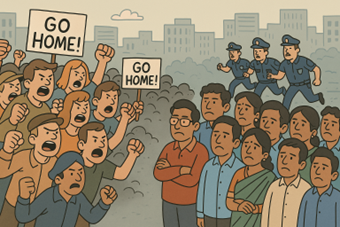



From boardrooms to hospitals, Indians face rising suspicion. This new normal demands resilience abroad and boldness at home.
By Ravishankar Kalyanasundaram
Across the Western world, the mood is unsettled. Growth is sluggish, energy bills are heavy, mortgages unaffordable, and jobs scarce. These are the ingredients of public frustration. And when voters are restless, politicians often reach for the same trick: blame the outsider.
This time, Indians are in the crosshairs. From Sydney to San Francisco, Birmingham to Berlin, the immigrant once praised for hard work is now seen with suspicion.
From Tolerated to Targeted
For decades, Indians abroad were tolerated in roles that didn’t threaten anyone—corner shops, cabs, night shifts in hospitals. But as they moved higher—into boardrooms, universities, even prime ministerial offices—their success turned the spotlight, and the spotlight made them targets.
Why Indians?
Part of it is scapegoating. When services falter or unemployment rises, a doctor in Birmingham or an engineer in California becomes a stand-in for systemic failures. Part of it is identity politics. Right-wing movements thrive on “us versus them,” and Indians, visible and successful in large numbers, fit the role of “them” too easily. And part of it is imitation. In today’s digital world, rhetoric travels: “they take our jobs” in Washington becomes “they strain our housing” in Sydney, “they undermine our culture” in Berlin.
The Scale of the Diaspora
Over six million Indians live across the U.S., U.K., Australia, Germany, and Canada. They are one of the most visible immigrant groups in the West—present in hospitals, classrooms, and city councils. Their prominence is precisely what makes them both indispensable and, at times, vulnerable.
Indispensable, Yet Resented
The irony is stark. In Britain’s NHS, Indian doctors keep hospitals alive. In Silicon Valley, Indian engineers are the backbone of the digital economy. In Germany, they are actively recruited to keep industries afloat. Yet the more vital they are, the easier it is to accuse them of “taking opportunities.”
Can India Fix This?
Delhi cannot erase the politics of other countries. For leaders abroad, blaming immigrants is cheap and popular. Nor can India summon millions of its diaspora home.
At best, New Delhi can provide stronger legal and consular help, keep raising the issue in diplomatic forums, and use its cultural reach to tell a counter-story—that Indians abroad are builders, not burdens. At times it may respond with reciprocity in visas or trade. But even these steps have limits. The truth is, politics abroad follows its own logic.
When Collective Action Works
The diaspora has more room to move. And history shows that when Indians act collectively, perceptions shift.
In the U.K., the Indian Doctors’ Association worked with the NHS during COVID, organising vaccination drives in London and Leicester, earning public gratitude. In the U.S., figures like Fareed Zakaria and Mindy Kaling have chipped away at stereotypes by telling Indian stories in mainstream spaces. Rishi Sunak as U.K. Prime Minister and Kamala Harris as U.S. Vice President are dramatic markers of political integration. And in everyday life, Indian associations running Diwali festivals in Sydney or food drives in New Jersey quietly turn “migrants” into neighbours.
These gestures don’t erase hostility overnight, but they chip away at prejudice. Narratives thrive in silence; they weaken when challenged by lived contribution.
Reverse Brain Drain: A Possibility?
If scapegoating abroad is the new normal, can India use this moment to turn the tide? Could it create a platform big enough to make coming back feel like a step up, not a step down?
Signs are visible. Bengaluru and Hyderabad are now home to AI start-ups and research labs that rival Silicon Valley. Hospitals and biotech clusters are expanding, offering roles where doctors and scientists can lead at home. Solar corridors, battery plants, and hydrogen hubs suggest clean-energy industries that can absorb engineers scattered across the West. Education is opening through foreign tie-ups and new campuses, and space and defence—once closed—now welcome private ventures alongside ISRO.
It won’t reverse brain drain overnight. But the returning professional is no longer rare: the software engineer who once queued for a U.S. visa now runs an AI firm in Bengaluru; the cardiologist trained in London heads a hospital in Kochi; the scientist from Germany sets up a green-tech lab in Hyderabad. These are not statistics, they are small stories—and multiplied, they can change the narrative.
The Indian Way Forward
The “American Dream” no longer looks as secure. Visas are tighter, rhetoric harsher, ceilings clearer. India’s challenge is to make its own dream credible enough to compete. That means investing in research, building strong institutions, funding entrepreneurs, and giving people room to rise at home. It means telling the diaspora that India is not just a homeland of memory, but a land of opportunity.
Closing Note
The West may continue to scapegoat immigrants. That tide won’t turn soon. But Indians have weathered worse storms—colonial prejudice, exclusion, open hostility. Each time, they rebuilt their place by proving indispensable.
This moment will be no different. With diplomacy abroad, collective action by the diaspora, and boldness at home, India can turn resentment into renewal. In time, the story may flip again—from scapegoat to nation-builder, both overseas and within India itself.